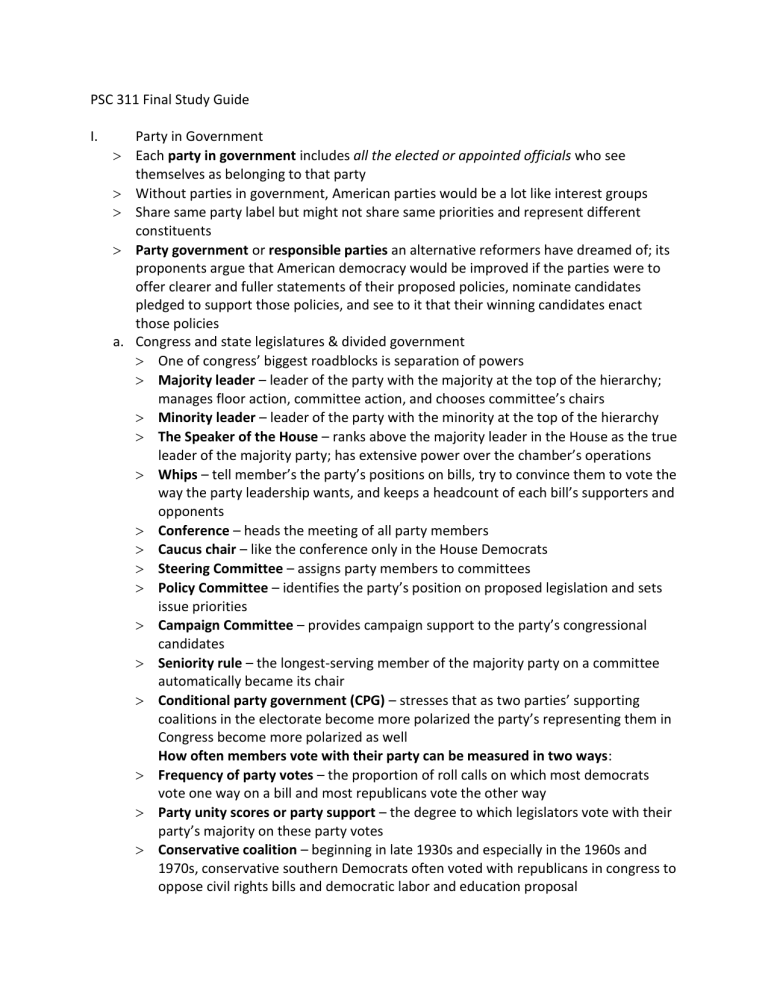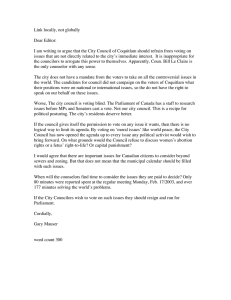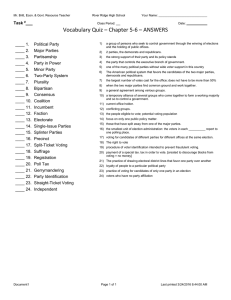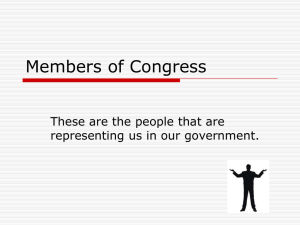
PSC 311 Final Study Guide I. Party in Government Each party in government includes all the elected or appointed officials who see themselves as belonging to that party Without parties in government, American parties would be a lot like interest groups Share same party label but might not share same priorities and represent different constituents Party government or responsible parties an alternative reformers have dreamed of; its proponents argue that American democracy would be improved if the parties were to offer clearer and fuller statements of their proposed policies, nominate candidates pledged to support those policies, and see to it that their winning candidates enact those policies a. Congress and state legislatures & divided government One of congress’ biggest roadblocks is separation of powers Majority leader – leader of the party with the majority at the top of the hierarchy; manages floor action, committee action, and chooses committee’s chairs Minority leader – leader of the party with the minority at the top of the hierarchy The Speaker of the House – ranks above the majority leader in the House as the true leader of the majority party; has extensive power over the chamber’s operations Whips – tell member’s the party’s positions on bills, try to convince them to vote the way the party leadership wants, and keeps a headcount of each bill’s supporters and opponents Conference – heads the meeting of all party members Caucus chair – like the conference only in the House Democrats Steering Committee – assigns party members to committees Policy Committee – identifies the party’s position on proposed legislation and sets issue priorities Campaign Committee – provides campaign support to the party’s congressional candidates Seniority rule – the longest-serving member of the majority party on a committee automatically became its chair Conditional party government (CPG) – stresses that as two parties’ supporting coalitions in the electorate become more polarized the party’s representing them in Congress become more polarized as well How often members vote with their party can be measured in two ways: Frequency of party votes – the proportion of roll calls on which most democrats vote one way on a bill and most republicans vote the other way Party unity scores or party support – the degree to which legislators vote with their party’s majority on these party votes Conservative coalition – beginning in late 1930s and especially in the 1960s and 1970s, conservative southern Democrats often voted with republicans in congress to oppose civil rights bills and democratic labor and education proposal Cartel theory – according to this theory another vital source of party leaders’ power is their ability to control the legislative agenda b. Executive and judiciary Even unified party control of congress does not guarantee success American judges and executives are even party identifiers Presidents can be very persuasive recruiters or “decruiters”, especially when their approval rate is high Coattail effects – presidents ran at the top of their ticket and the rest of the party ticket came into office clinging to their sturdy coattails Justices appointed by republican presidents: Roberts, Kennedy, Alito, Thomas Justices appointed by democratic presidents: Ginsburg, Breyer, Sotomayor, Kagan Other notes Especially within the framework of the 2012 election, Obama had an advantage over Romney as a personality. Leadership, morality, and caring about people can be considered a candidate trait. Prospective voters tend to be moderate Prospective issue voters cast their vote based on campaign promises War and terrorism, health care, and the economy have been major issues in recent presidential campaigns In 2012, issue voters were likely to vote for Romney If each candidate takes a clear stand on the issues the number of prospective voters increases Retrospective voters cast a vote based on the performance of the previous administration, look at end results/outcome of an administration, and see the past as a predictor of the future Economical and foreign affairs often lead to retrospective voting because goals/desired outcomes are clear, but the means to achieve them are not Retrospective voting is ultimately more powerful than prospective voting Red State, Blue State, Rich State, Poor State In the culture war, orthodoxy hold family and religious values and beliefs in definable authority In the culture war, progressives believe in change, adjustment, and reinterpretation Teaching evolution in school, abortion, and transgender rights are all examples of a culture war issue An evangelical protestant is likely orthodox in the war, while a mainline protestant is likely progressive Why rich states vote democrat but poor states vote republican is the main theme of Red State, Blue State This paradox can be explained by understanding that voting is cultural, not classist The rich are more polarized and determines if a state is red or blue because of the culture war In rich states, the rich and poor are not very different politically, in poor states they are. Gelman’s ecological fallacy is failing to realize there is both an economic and cultural dimension in voting Income predict voting most effectively in red states Church attendance is high in red states, contributing to culturally-based voting Cultural issues are important to voters who are more financially secure Average americans are less polarized than political elites Congress members are pushed to opposite political poles by interest groups and activists, contributors, and primary election voters In rich states, government gives more benefits to the rich Low income voters are similar in red and blue states Party in congress Responsible parties: parties should stick to the programs on which they ran After 1910, the U.S. political system experienced a long-term decline in party voting and congressional committee chairs rivaling party leaders for power In the 1970s junior committee democrats joined the republicans, ultimately shifting power back to the speaker Due to the leadership of Speaker Newt Gingrich, the 104 th Congress saw a republican revolution, formulated a contract with America, and put six year term limits on committee leaders. A fine for ethics violation, a stand-off with President Bill Clinton, and a loss of republican seats led to Newt Gingrich’s political decline The democrats bounced back in 2006 under the leadership of Speaker Nancy Pelosi Divided government occurs when presidency and at least one body of congress are ruled by different parties Under divided government it is theoretically easier to represent the will of the people and a party can be held accountable for their policies Divided government is not a new occurrence, but has increased recently in presidential election years TV has made voters like presidential candidates for their personalities, not party and that might explain why presidential election years have recently produced divided government Majority-minority districts are important because it helps republicans get elected in other districts, as all other districts are majority-minority A split ticket voter is a voter who votes for both parties on the same ballot A desire to express a moderate, centrist, middle-of-the-road preference, to balance power between presidency and congress, and for the compromise that occurs in divided government might produce split-ticket voters. Governmental degeneration is the idea that unified government fosters excess and waster Ticket splitters are created when they “vote against” the activists who pull them to political extremes. Evaluations of divided government are it is inefficient and unaccountable and it curbs excess For the most part, people feel indifferent about divided government Regarding the passing of legislation, divided government passes less landmark legislation, but more trivial laws The probability of war decreases under divided government Under divided government spending decreases, as the parties provide checks on each other’s powers Responsible government campaigns on programs and sticks with campaign promises The Party in the Judiciary The supreme court can be viewed as a policy-making body because it has the power of judicial review The current judicial era is defined by the relationship between government and the individual Supreme court justices are partisan because internal pressure from their own morals, values, and beliefs The president dominates the recruitment process for the supreme court and the U.S. court of appeals The senate rejection of a supreme court is likely to occur when the president and senate majority are of opposite parties and when the nomination occurs in the last year of a president’s second term The supreme court consists of 4 democrats, 4 republicans, and 1 swing voter





